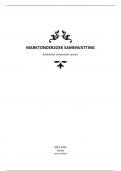lOMoARcPSD|22220002
MARKTONDERZOEK SAMENVATTING
Katholieke Universiteit Leuven
2022-2023
D0E48A
Senne Desmet
, lOMoARcPSD|22220002
Onderzoeken hoe we het best aan marketing kunnen doen.
‘Marketing without data is like driving with your eyes closed.’
MODULE 1
CHAPTER 1: INTRODUCTION TO MARKETING RESEARCH
Marketing is the activity, set of institutions, and processes for creating, communicating, delivering, and
exchanging offerings that have value for customers, clients, partners, and society at large.
Marketing research is the function that links the consumer, customer, and public to the marketer through
information -- information used to identify and define marketing opportunities and problems; generate,
refine, and evaluate marketing actions; monitor marketing performance; and improve understanding of
marketing as a process. Marketing research specifies the information required to address these issues,
designs the method for collecting information, manages and implements the data collection process,
analyses the results, and communicates the findings and their implications.
MARKETING RESEARCH PROCESS
Stage 1: Problem definition
- Business problem/ opportunity
→ Defined based on interactions between
o Environmental context of the problem/ opportunity
o Management decision problems
o Marketing research problems
Stage 2: Research approach developed
- Key is to have some theoretical foundations (i.e., academic literature): As a foundation for the
research design
→ In order to help you decide
o What (e.g., concepts) should be measured
o How it should be measured (i.e., appropriate scales)
o More: e.g., how to collect data, how to analyze data, how to report findings, etc.
Stage 3: Research design developed
- Goal: a blue-print for conducting the marketing research project
o Final Conceptual Framework: what to measure (which variable?), how to measure
(scaling)
o How to obtain data (= sample decisions such who, how many, which type of
sample)
o How to handle the data:
▪ Type of Analysis (exploratory, descriptive, causal)
▪ Analysis flow/ procedure (e.g., missing values, bias tests, handling
categorical variables, test measurement instrument, sample descriptives,
correlation table, descriptive statistics, collinearity tests, regression,
moderation analyses, etc.)
Stage 4: Fieldwork or data collection
- Goals: collecting the required data
o Both secondary (e.g., database, literature, past research, etc.) and primary data
o Primary data could be by means of both qualitative (e.g., in-
, lOMoARcPSD|22220002
depth interviews → tekst) and quantitative (e.g., questionnaire
→ cijfers) research
Stage 5: Data preparation and analysis
- Data preparation
o Includes the editing, coding, transcription and verification of the data
- Analysis
o Qualitative research techniques (e.g., Topic modeling)
o Quantitative research techniques (e.g., regression)
Stage 6: Report preparation and presentation/ knowledge dissemination:
- Written
o A report → goed nadenken wie u klant is/ visueel sterk!
o Make it appealing, include tables and figures (that stand on themselves), give
(action-oriented) key-take aways, report limitations, give recommendations …
o Use appendices (for methodological details)
- Spoken
o A presentation
o Make it managerial appealing, include discussion and Q&A
- Roland Rust: “What should companies know & do differently based on the insights
obtained from your results?
CHAPTER 2: DEFINING THE MARKETING RESEARCH PROBLEM AND DEVELOPING A RESEARCH APPROACH
1. Process of defining a marketing research problem/opportunity
2. Importance of strong theorethical foundation
3. A research model (conceptual framework): verbal, graphical and analytical model
& research questions & research hypotheses
➔ Wisselwerking tussen deze drie topics





